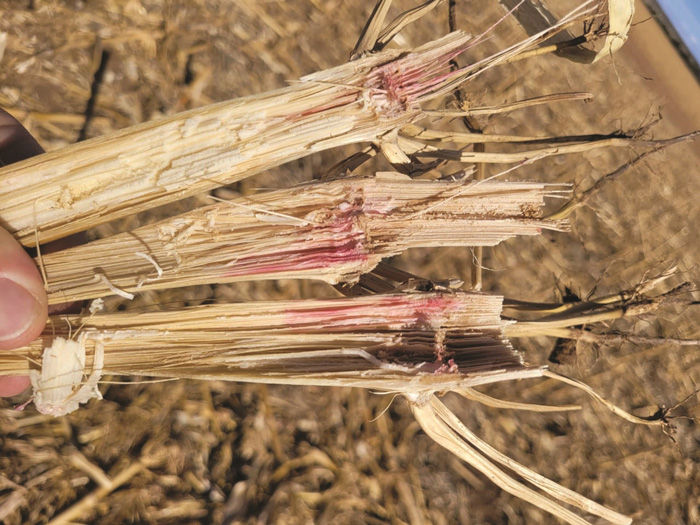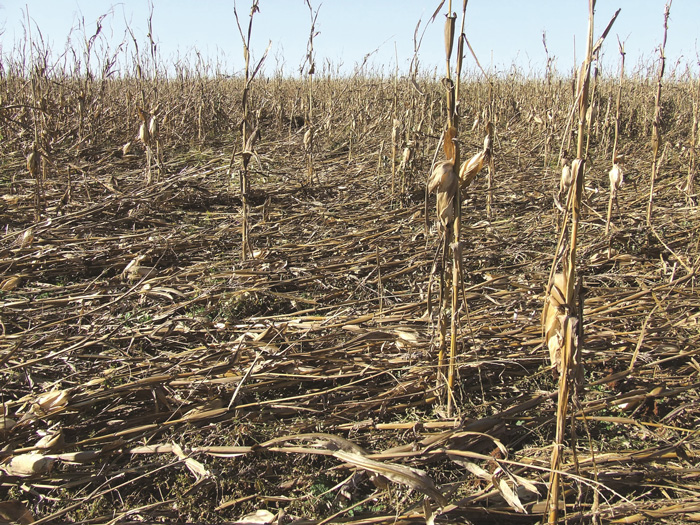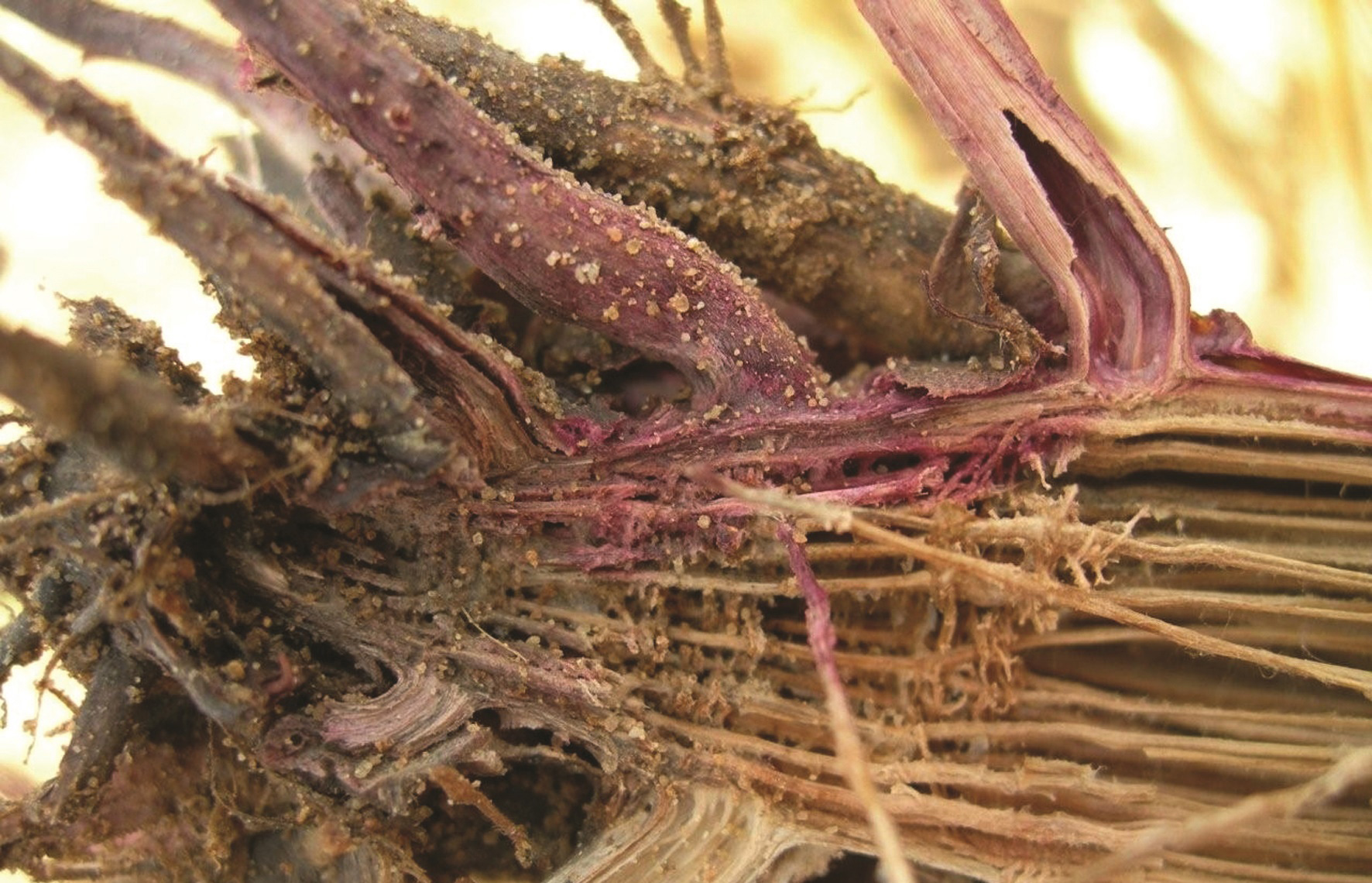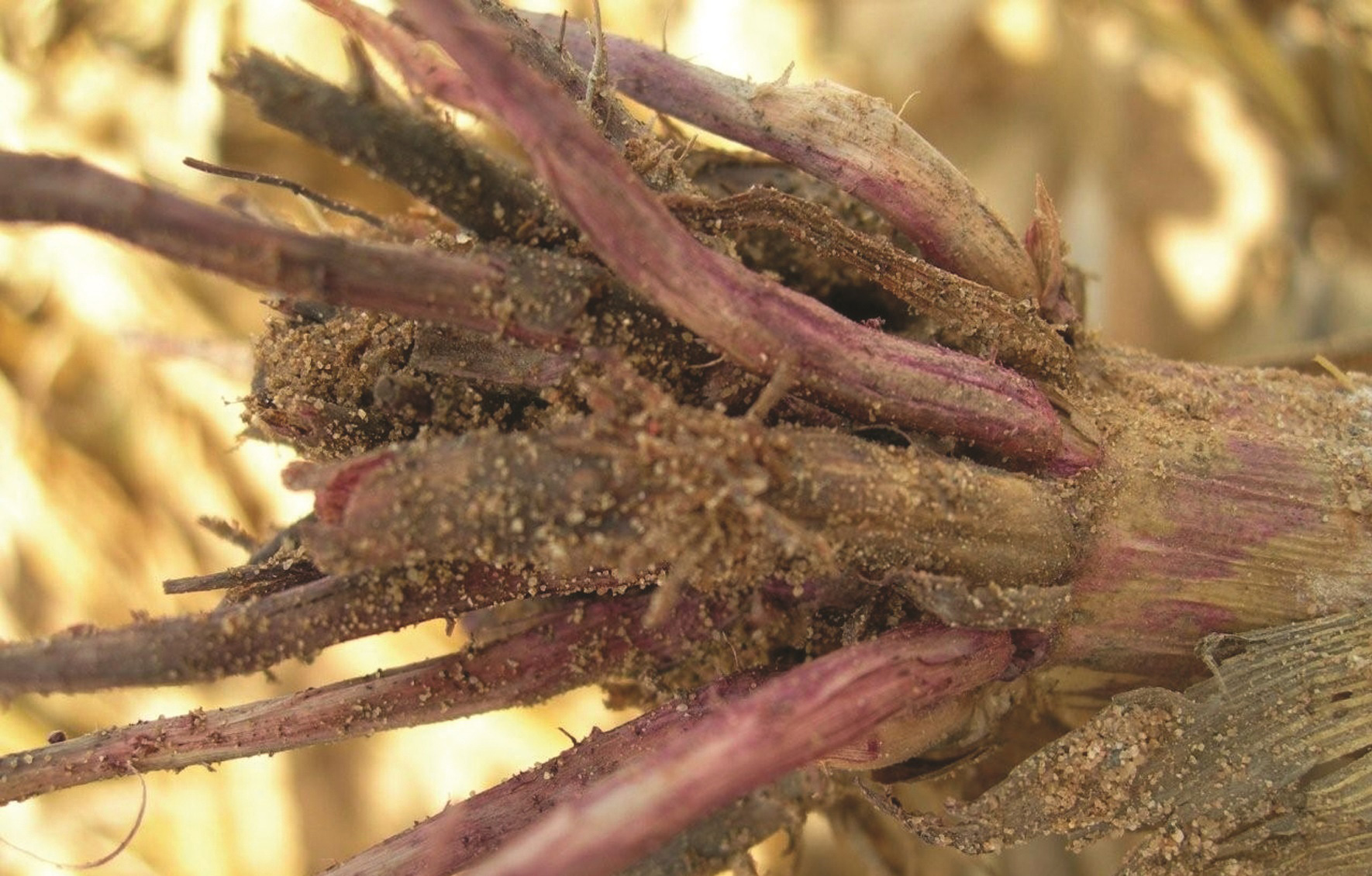
ARC-Grain Crops, Potchefstroom

Dr Belinda Janse
van Rensburg,
ARC-Grain Crops, Potchefstroom
Gibberella stalk rot (Photo 1) is caused by fungus pathogens within the Fusarium graminearum species complex (FGSC). The primary crop hosts of FGSC include maize, oat, barley, rye, sorghum and wheat. FGSC is referred to as a complex because, prior to 2000, it was presumed that Gibberella ear rot, stalk rot and wheat head blight were all caused by the same species.
However, molecular techniques applied to identify these species indicated that isolates collected within this complex differed genetically. Taxonomists concurrently started dividing the complex into several species based on their genetics, mycotoxin profiles and crop host preferences. Recent research showed that the complex of fungi that were classified as F. graminearum, had host, climatic and regional preferences. Genetic analyses divided them into eight biogeographically distinct lineages, now known as the F. graminearum species complex (FGSC), instead of the previous name F. graminearum or Gibberella zeae.
This was later revised to 13 species, including F. austroamericanum (lineage 1), F. meridionale (lineage 2), F. boothii (lineage 3), F. mesoamericanum (lineage 4), F. acacia-mearnsii (lineage 5), F. asiaticum (lineage 6), F. graminearum sensu stricto (lineage 7), F. cortaderiae (lineage 8), F. brasilicum (no lineage number), F. aethiopicum (no lineage number), F. gerlachii (no lineage number), F. vorosii (no lineage number) and F. ussurianum (no lineage number). Of this complex F. asiaticum, F. austroamericanum, F. boothii, F. meridionale and F. graminearum sensu stricto have been shown to be associated with maize.

These five species differ in the degree to which they cause disease (virulence) and to plant tissue preference. Of these species, F. boothii is the most virulent and F. meridionale the least. Little research was done to determine which of these five species within the complex are the main causal agents for which disease on the different crops. However, in South Africa all of them were isolated and identified from maize roots and crowns.
Only F. boothii has been recorded in maize ears, but the causal species of maize stalk rots still need to be confirmed and clarified. A great scope therefore exists for this complex to be studied in South Africa, including the various tissues and crops from which they can be isolated as well as the epidemiology of each species. For the purposes of this article, FGSC will be used as the terminology to describe Gibberella stalk rot of maize.
Economic importance
Stalk rot results in yield losses due to impaired grain filling, premature senescence and lodging (limits production and harvesting of ears). In addition, mycotoxins produced by these fungi can render infected stalk tissues unfit for animal consumption. Stalk rot is a common problem in maize production areas worldwide.
Although it is difficult to estimate precise yield loss, FGSC stalk rot can cause extensive economic losses due to premature plant death, interference with translocation of water and nutrients because of fungal growth on xylem and phloem tissues in the stalk during grain fill (poor grain fill) as well as lodging of plants due to weakened stems during favourable environmental conditions. Kernels on affected ears are smaller than healthy plant grain and are often loose on the ear (can be quantified by using thousand kernel weight as a parameter). Lodging of infected plants complicates mechanical operations. Plants then need to be picked up and harvested by hand, which in turn increases harvest time, labour and input costs.
Symptoms
Symptoms of Gibberella stalk rot are like that of other stalk rots, but can be distinguished by its pink/red discolouration of the infected plant tissue. Affected plants wilt and healthy, light green leaves turn dull green and may eventually turn brown. The lower stalks become straw-coloured, while the internal pith disintegrates, leaving only the vascular bundles partially intact. The disintegration of stem tissue causes stem lodging (Photo 2) and rotting of the crown (Photo 3) and root system leads to root lodging (Photo 4). Small, round, black fruiting bodies (perithecia) may be produced superficially on the stalks, often at the internode of the stalk.



Epidemiology
The perithecia on maize stubble produce ascospores under wet, warm conditions. These ascospores are disseminated by wind and will infect maize plants in the proximity of the source. During the summer, inoculum may also be produced as conidia. Stalk infections may occur during the vegetative growth stage, but the symptoms thereof generally manifest shortly after pollination and at onset of grain fill and develop at the origin of the leaf sheaths or around the brace roots. The fungus may also infect the plant through its roots and then grow up into the lower stem.
Control
Crop rotation
A maize-based crop rotation system with legumes or sunflower will allow maize stubble to break down and not provide a suitable host for the fungus to survive on, thereby reducing the inoculum. However, recently published work indicates that the possible host range on which the FGSC may infect or survive is far wider than originally thought. Studies conducted in France suggested that certain species within the FGSC are highly saprophytic and may survive on non-host organic material. This must still be confirmed under local conditions, but it may explain FGSC stalk rots occurring on fields not previously planted to maize. Such FGSC stalk rots were observed locally in fields with previous high FGSC incidence that were planted to lucerne for a number of years before returning once again to maize.
Resistance
Hybrids with resistance to other stalk rots (such as Diplodia) may also show resistance to Gibberella stalk rot. However, this resistance may rather be due to breeders that focused on plant stalk strength and standability and not directly to the disease. In fact, the stronger stalks may increase the survival of stalk rot pathogens because these stalks break down slower and the natural decay process is delayed.
Although a lot of effort has been made to select hybrids with stalk rot resistance, the main consideration is still high yield production. Genotypes that produce higher yields tend to have bigger ears, which act as larger sinks and a greater demand for carbohydrates in the plants. The higher demand because of the larger ears results in reduced carbohydrate levels in the lower stem, which predispose the plant to stalk rot. The balance between breeding for resistance to stalk rot and breeding for high yield is, therefore, delicate.
Nutrients and stress reduction
Common stress conditions include high nitrogen and low potassium fertility and a high soil moisture or water logging in the mid to late season following a dry, early season experienced during grain fill. A high incidence of leaf diseases causes a reduction of the photosynthetic area of the plant, adding further stress and predisposition to stalk rot. Physical damage creating wounds (insects or hail) that allow the pathogen to enter the maize plant may also predispose the plant to stalk rot.
Cultural practices that reduce plant stress also reduce incidence of stalk rot. Regenerative agriculture (conservation tillage) practices that reserve soil moisture and improve soil nutrient levels may reduce plant stress but may, on the other hand, increase inoculum levels. This play-off between soil and moisture conservation and increased disease levels needs to be breached with innovative research efforts.
Chemical control
There are no fungicides that are directly registered for the control of Gibberella stalk rot. However, fungicide applications for the control of leaf diseases may reduce stress on the plant, thus lessening stalk rot severity and ultimately lodging.
Biological control
There are several biological products presently marketed in South Africa that are alleged to reduce Gibberella stalk rots, generating interest by agronomists and producers. However, the efficacy of these products needs to be confirmed in independent studies by impartial institutions to confirm or refute the claims of efficacy. Biological agents should therefore be tested under field conditions with accurate disease quantification techniques such as qPCR to quantify the amount of the target fungus within the stalk. Even though many biological products show antagonistic properties against certain fungal pathogens in the laboratory, it needs to be confirmed in an environment where soil factors vary and may contain a wide range of soil microbes that may influence this efficacy. It is recommended that producers request field data that confirm efficacy before using these products.
In conclusion, stalk rots still require a lot of research aimed at developing integrated disease management systems. Research is also required on Fusarium spp. of the FGSC involved in Gibberella stalk rots as well as the epidemiology of these species before integrated systems that are based on accurate scientific data can be developed.





























